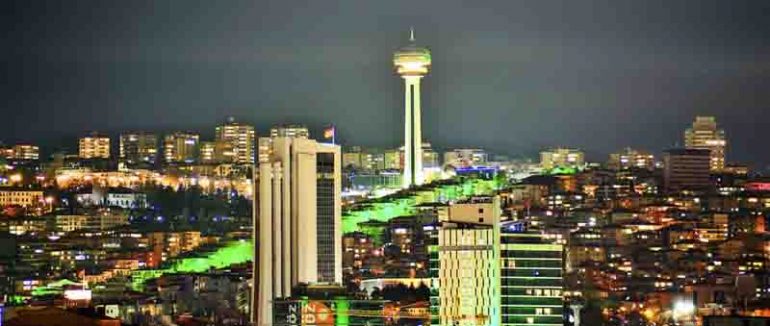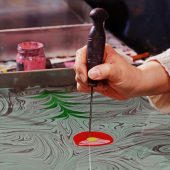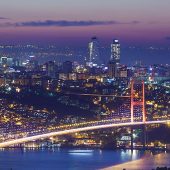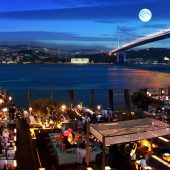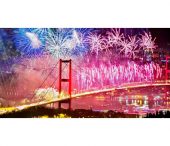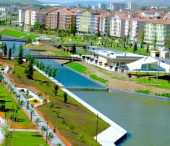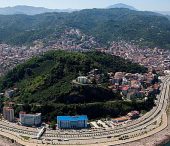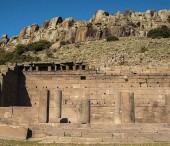Ankara is the capital of Turkey and the country's second largest city after İstanbul. The city has a mean elevation of 850 m (2800 ft), and as of 2007 the city had a population of 3,901,201, which includes eight districts under the city's administration. Ankara also serves as the capital of the Province of Ankara, whose population stood at 5.270.575 in 2015.
As with many ancient cities, Ankara has gone by several names over the ages: The Hittites gave it the name Ankuwash before 1200 BC. The Galatians and Romans called it Ancyra. In the classical, Hellenistic, and Byzantine periods it was known as Ἄγκυρα Ánkyra. It was also known as Angora after it fell to the Seljuks in 1073, and was so known up until 1930.
Centrally located in Anatolia, Ankara is an important commercial and industrial city. It is the center of the Turkish Government, and houses all foreign embassies. It is an important crossroads of trade, strategically located at the center of Turkey's highway and railway networks, and serves as the marketing center for the surrounding agricultural area. The city was famous for its long-haired Angora goat and its prized wool (mohair), a unique breed of cat (Angora cat), white rabbits and their prized wool (Angora wool), pears, honey, and the region's muscat grapes.
Ankara is situated upon a steep and rocky hill, which rises 150 m above the plain on the left bank of the Enguri Su, a tributary of the Sakarya (Sangarius) river. The city is located at 39°52'30" North, 32°52' East (39°52′30″N 32°49′60″E / 39.875, 32.8333Coordinates: 39°52′30″N 32°49′60″E / 39.875, 32.8333), about 351 kilometres (218 mi) to the southeast of Istanbul, the country's largest city. Ankara is one of the driest places in Turkey and is surrounded by a barren steppe vegetation, with various Hittite, Phrygian, Hellenistic, Roman, Byzantine, and Ottoman archaeological sites. It has a harsh, dry continental climate with cold, snowy winters and hot, dry summers. Rainfall occurs mostly during the spring and autumn.
The hill which overlooks the city is crowned by the ruins of the old castle, which adds to the picturesqueness of the view, but only a few historic structures surrounding the old citadel have survived to our date. There are, however, many finely preserved remains of Hellenistic, Roman and Byzantine architecture, the most remarkable being the Temple of Augustus and Rome (20 BC) which is also known as the Monumentum Ancyranum.
History
The region's vibrant history can be traced back to the Bronze Age Hatti civilization, which was succeeded in the 2nd millennium BC by the Hittites, in the 10th century BC by the Phrygians, and later by the Lydians, Persians, Macedonians, Galatians, Romans, Byzantines, and Turks (Seljuk Empire then Ottoman Empire and then Turkey).
The oldest settlements in and around the city center of Ankara belong to the Hatti civilization which lived during the Bronze Age. Artifacts discovered in the city have revealed that the Hittites called Ankara with the name Ankuwash prior to 1200 BC. The city significantly grew in size and importance under the Phrygians starting from around 1000 BC, experiencing a large expansion following the mass migration from Gordion, the capital of Phrygia, after an earthquake which severely damaged that city in antiquity. In Phrygian tradition, King Midas was venerated as the founder of Ancyra, but Pausanias mentions that the city was actually far older, in line with the present-day knowledge that we have on its history.
Phrygian rule was succeeded first by Lydian and later by Persian rule, though the strongly Phrygian character of the peasantry remained, as evidenced by the gravestones of the much later Roman period. Persian sovereignty lasted until the Persians' defeat at the hands of the Macedonian king Alexander the Great who conquered the city in 333 BC. Alexander came from Gordion to Ankara and stayed in the city for a short period. After his death at Babylon in 323 BC and the subsequent division of his empire amongst his generals, Ankara and its environs fell into the share of Antigonus. Apart from the Phrygian period in which the city experienced its largest expansion in the ancient times, another important expansion took place under the Greeks of Pontos who came there and developed the city as a trading center for the commerce of goods between the Black Sea ports and Crimea to the north; Assyria, Cyprus, and Lebanon to the south; and Georgia, Armenia and Persia to the east. By that time the city also took its name Áγκυρα - Ànkyra (meaning anchor in Greek) which is still used by the Turks with the slightly modified form of Ankara.
In 278 BC, the city, along with the rest of central Anatolia, was occupied by the Celtic race of Galatians, who were the first to make Ankara one of their main tribal centres, the headquarters of the Tectosages tribe. Other centres were Pessinos, today's Balhisar, for the Trocmi tribe; and Tavium, to the east of Ankara, for the Tolstibogii tribe. The city was then known as Ancyra. The Celtic element was probably relatively small in numbers; a warrior aristocracy which ruled over Phrygian-speaking peasants. However, the Celtic language continued to be spoken in Galatia for many centuries. At the end of the 4th century AD, St. Jerome, a native of Galatia, observed that the language spoken around Ankara was very similar to that being spoken in the northwest of the Roman world near Trier.
The city was subsequently conquered by Augustus in 25 BC and passed under the control of the Roman Empire. Now the capital city of the Roman province of Galatia, Ancyra continued to be a center of great commercial importance. Ankara is also famous for the Monumentum Ancyranum (Temple of Augustus and Rome) which contains the official record of the Acts of Augustus, known as the Res Gestae Divi Augusti, an inscription cut in marble on the walls of this temple. The ruins of Ancyra still furnish today valuable bas-reliefs, inscriptions and other architectural fragments.
Augustus decided to make Ancyra one of three main administrative centres in central Anatolia. The town was then populated by Phrygians and Celts—the Galatians who spoke a language closely related to Welsh and Gaelic. Ancyra was the center of a tribe known as the Tectosages, and Augustus upgraded it into a major provincial capital for his empire. Two other Galatian tribal centres, Tavium near Yozgat, and Pessinus (Balhisar) to the west, near Sivrihisar, continued to be reasonably important settlements in the Roman period, but it was Ancyra that grew into a grand metropolis.
An estimated 200,000 people lived in Ancyra in good times during the Roman Empire, a far greater number than was to be the case after the fall of the Roman Empire until the early twentieth century. A small river, the Ankara Çayı, ran through the centre of the Roman town. It has now been covered over and diverted, but it formed the northern boundary of the old town during the Roman, Byzantine and Ottoman periods. Çankaya, the rim of the majestic hill to the south of the present city center, stood well outside the Roman city, but may have been a summer resort. In the 19th century, the remains of at least one Roman villa or large house were still standing not far from where the Çankaya Presidential Residence stands today. To the west, the Roman city extended until the area of the Gençlik Park and Railway Station, while on the southern side of the hill, it may have extended downwards as far as the site presently occupied by Hacettepe University. It was thus a sizeable city by any standards and much larger than the Roman towns of Gaul or Britannia.
Ancyra's importance rested on the fact was that it was the junction point where the roads in northern Anatolia running north-south and east-west intersected. The great imperial road running east passed through Ankara and a succession of emperors and their armies came this way. They were not the only ones to use the Roman highway network, which was equally convenient for invaders. In the second half of the 3rd century, Ancyra was invaded in rapid succession by the Goths coming from the west (who rode far into the heart of Cappadocia, taking slaves and pillaging) and later by the Arabs. For about a decade, the town was one of the western outposts of one of the most brilliant queens of the ancient world, the Arab empress Zenobia from Palmyra in the Syrian desert, who took advantage of a period of weakness and disorder in the Roman Empire to set up a short-lived state of her own.
The town was reincorporated into the Roman Empire under the Emperor Aurelian in 272. The tetrarchy, a system of multiple (up to four) emperors introduced by Diocletian (284-305), seems to have engaged in a substantial programme of rebuilding and of road construction from Ankara westwards to Germe and Dorylaeum (now Eskişehir).
In its heyday, Roman Ankara was a large market and trading center but it also functioned as a major administrative capital, where a high official ruled from the city's Praetorium, a large administrative palace or office. During the 3rd century, life in Ancyra, as in other Anatolian towns, seems to have become somewhat militarised in response to the invasions and instability of the town. In this period, like other cities of central Anatolia, Ankara was also undergoing Christianisation.
Early martyrs, about whom little is known, included Proklos and Hilarios who were natives of the otherwise unknown village of Kallippi, near Ancyra, and suffered repression under the emperor Trajan (98-117). In the 280s AD we hear of Philumenos, a Christian corn merchant from southern Anatolia, being captured and martyred in Ankara, and Eustathius.
Like in other Roman towns, the reign of Diocletian marked the culmination point of repression against Christians. In 303, Ancyra was one of the towns where the co-Emperors Diocletian and his deputy Galerius launched their anti-Christian persecution. In Ancyra, their first target was the 38-year-old Bishop of the town, whose name was Clement. Clement's life describes how he was taken to Rome, then sent back, and forced to undergo many interrogations and hardship before he, and his brother, and various companions were put to death. The remains of the church of St. Clement can be found today in a building just off Işıklar Caddesi in the Ulus district. Quite possibly this marks the site where Clement was originally buried. Four years later, a doctor of the town named Plato and his brother Antiochus also became celebrated martyrs under Galerius. Theodotus of Ancyra is also venerated as a saint.
However, the persecution proved unsuccessful and in 314 Ancyra was the center of an important council of the early church; which considered ecclesiastical policy for the reconstruction of the Christian church after the persecutions, and in particular the treatment of 'lapsi'—Christians who had given in and conformed to paganism during these persecutions. Three councils were held in the former capital of Galatia in Asia Minor, during the 4th century. The first, an orthodox plenary synod, was held in 314, and its 25 disciplinary canons constitute one of the most important documents in the early history of the administration of the Sacrament of Penance. Nine of them deal with conditions for the reconciliation of the lapsi; the others, with marriage, alienations of church property, etc.
Though paganism was probably tottering in Ancyra in Clement's day, it may still have been the majority religion. Twenty years later, Christianity and monotheism had taken its place. Ancyra quickly turned into a Christian city, with a life dominated by monks and priests and theological disputes. The town council or senate gave way to the bishop as the main local figurehead. During the middle of the 4th century, Ancyra was involved in the complex theological disputes over the nature of Christ, and a form of Arianism seems to have originated there.
The synod of 358 was a Semi-Arian conciliabulum, presided over by Basil of Ancyra. It condemned the grosser Arian blasphemies, but set forth an equally heretical doctrine in the proposition that the Son was in all things similar to the Father, but not identical in substance.
In 362-363, the Emperor Julian the Apostate passed through Ancyra on his way to an ill-fated campaign against the Persians, and according to Christian sources, engaged in a persecution of various holy men. The stone base for a statue, with an inscription describing Julian as "Lord of the whole world from the British Ocean to the barbarian nations", can still be seen, built into the eastern side of the inner circuit of the walls of Ankara Castle. The Column of Julian which was erected in honor of the emperor's visit to the city in 362 still stands today. In 375, Arian bishops met at Ancyra and deposed several bishops, among them St. Gregory of Nyssa. The modern Ankara, also known in some Western texts as Angora, remains a Roman Catholic titular see in the former Roman province of Galatia in Asia Minor, suffragan of Laodicea. Its episcopal list is given in Gams, "Series episc. Eccl. cath."; also that of another Ancyra in Phrygia Pacatiana.
In the later 4th century Ancyra became something of an imperial holiday resort. After Constantinople became the East Roman capital, emperors in the 4th and 5th centuries would retire from the humid summer weather on the Bosphorus to the drier mountain atmosphere of Ancyra. Theodosius II (408-450) kept his court in Ancyra in the summers. Laws issued in Ancyra testify to the time they spent there. The city's military as well as logistical significance lasted well into the long Byzantine reign. Although Ancyra fell into the hands of several Arab armies numerous times after the 6th century, it remained an important crossroads polis within the Byzantine Empire until the late 11th century.
In 1071, the Seljuk Sultan Alparslan opened the gates of Anatolia for the Turks with his victory at the Battle of Manzikert (Malazgirt). He then annexed Ankara, an important location for military transportation and natural resources, to his territory in 1073. Orhan I, second Bey of the Ottoman Empire, captured the city in 1356. Another Turkic ruler, Timur, defeated the Ottomans at the Battle of Ankara in 1402 and captured the city, but in 1403 Ankara was again under Ottoman control.
Following the Ottoman defeat at World War I, the Ottoman capital Istanbul and much of Anatolia were occupied by the Allies, who planned to share these lands between the United Kingdom, France, Italy and Greece, leaving the Turks only a small piece of land in central Asia Minor. In response, the leader of the Turkish nationalist movement, Kemal Atatürk, established the headquarters of his resistance movement in Ankara in 1920 (see Treaty of Sèvres and Turkish War of Independence). After the War of Independence was won, the Turkish nationalists replaced the Ottoman Empire with the Republic of Turkey on October 29, 1923. A few days earlier, Ankara had replaced İstanbul (formerly Constantinople) as the new Turkish capital city, on October 13, 1923.
After Ankara became the capital of the newly founded Republic of Turkey, new development divided the city into an old section, called Ulus, and a new section, called Yenişehir. Ancient buildings reflecting Roman, Byzantine, and Ottoman history and narrow winding streets mark the old section. The new section, now centered around Kızılay, has the trappings of a more modern city: wide streets, hotels, theaters, shopping malls, and high-rises. Government offices and foreign embassies are also located in the new section.
Ankara has experienced a phenomenal growth since it was made Turkey's capital. It was "a small town of no importance" when it was made the capital of Turkey. In 1924, the year after the government had moved there, Ankara had about 35,000 residents. By 1927 there were 44,553 residents and by 1950 the population had grown to 286,781. By 2007 its population was well over five million.
Population
Ankara has a population of 3,763,591 (2007 census) of which 1,870,831 are men and 1,892,760 are women.
Ankara is the capital city of the Ankara Province, which has a population of 5.270.575 (2015 census).
Attractions
Museums
Anıtkabir
is located on an imposing hill, Anıttepe quarter of the city, where the mausoleum of Mustafa Kemal Atatürk, founder of the Republic of Turkey, stands. Completed in 1953, it is an impressive fusion of ancient and modern architectural styles. An adjacent museum houses a wax statue of Atatürk, his writings, letters and personal items, as well as an exhibition of photographs recording important moments in his life and during the establishment of the Republic. Anıtkabir is open every day, while the adjacent museum is open every day except Mondays.
Ankara Ethnography Museum (Etnoğrafya Müzesi)
This museum is opposite the Opera House on Talat Paşa Boulevard, in the Ulus district. There is a fine collection of folkloric as well as Seljuk- and Ottoman-era artifacts.
Museum of Anatolian Civilizations (Anadolu Medeniyetleri Müzesi)
Situated at the entrance of Ankara Castle, it is an old "bedesten" (covered bazaar) that has been beautifully restored and now houses a unique collection of Paleolithic, Neolithic, Hatti, Hittite, Phrygian, Urartian, and Roman works as well as a major section dedicated to Lydian treasures.
State Art and Sculpture Museum (Resim-Heykel Müzesi)
This museum is close to the Ethnography Museum and houses a rich collection of Turkish art from the late 19th century to the present day. There are also galleries which host guest exhibitions.
War of Independence Museum (Kurtuluş Savaşı Müzesi)
This building, located on Ulus Square, was originally the first Parliament building (TBMM) of the Republic of Turkey. The War of Independence was planned and directed here as recorded in various photographs and items presently on exhibition. In another display, wax figures of former presidents of the Republic of Turkey are on exhibit.
TCDD Locomotive Museum
An open-air museum near the railway station on Celal Bayar Boulevard which traces the history of steam locomotion through the locomotives and artifacts on display.
Turkish Air Force Aviation Museum
Museum is near the İstanbul Road, Etimesgut. The museum is home to various aircraft which are or have served in Turkish Air Force (Jets like F-86, F-100, F-102, F-104, F-5, F-4 and cargo planes like C-160 transtall). Also a Hungarian Mig-21, a Pakistani Mig-19 and a Bulgarian Mig-17 are on display in the museum.
Archeological sites
Victory Monument (Zafer Anıtı)
Erected in 1927 on Zafer Square in the Sıhhiye quarter, it depicts Atatürk in uniform.
Ankara Citadel
The foundations of the citadel were laid by the Galatians on a prominent lava outcrop, and the rest was completed by the Romans. The Byzantines and Seljuks further made restorations and additions. The area around and inside the citadel, being the oldest part of Ankara, contains many fine examples of traditional architecture. There are also recreational areas to relax. Many restored traditional Turkish houses inside the citadel area have found new life as restaurants, serving local cuisine, music and of course, Rakı.
Roman Theatre
The remains, the stage, and the backstage can be seen outside the castle. Roman statues that were found here are exhibited in the Museum of Anatolian Civilizations (see above). The seating area is still under excavation.
Temple of Augustus and Rome
The temple, also known as the Monumentum Ancyranum, was built between 25 BC - 20 BC following the conquest of Central Anatolia by the Roman Empire and the formation of the Roman province of Galatia, with Ancyra (modern Ankara) as its administrative capital. After the death of Augustus in 14 AD, a copy of the text of Res Gestae Divi Augusti was inscribed on the interior of the pronaos in Latin, whereas a Greek translation is also present on an exterior wall of the cella. The temple, on the ancient Acropolis of Ancyra, was enlarged by the Romans in the 2nd century. In the 5th century it was converted into a church by the Byzantines. It is located in the Ulus quarter of the city.
Roman Bath
This bath has all the typical features of a classical Roman bath: a frigidarium (cold room), tepidarium (cool room) and caldarium (hot room). The bath was built during the reign of Emperor Caracalla in the 3rd century AD to honour Asclepios, the God of Medicine. Today, only the basement and first floors remain. It is situated in the Ulus quarter.
Column of Julian
This column, in Ulus, was erected in 362 to commemorate a visit by the Roman Emperor Julian. It stands fifteen meters high and has a typical leaf decoration on the capital.
Modern monuments
Monument to a Secure, Confident Future
This monument, located in Güven Park near Kızılay Square, was erected in 1935 and bears Atatürk's advice to his people: "Turk! Be proud, work hard, and believe in yourself."
Hatti Monument
Built in the 1970s on Sıhhiye Square, this impressive monument symbolizes the Hatti gods and commemorates Anatolia's earliest known civilization.
Mosques
Hacı Bayram Mosque
This mosque, in the Ulus quarter next to the Temple of Augustus, was built in the early 15th century in Seljuk style by an unknown architect. It was subsequently restored by architect Sinan in the 16th century, with Kütahya tiles being added in the 18th century. The mosque was built in honor of Hacı Bayram Veli, whose tomb is next to the mosque, two years before his death (1427-28). The usable space inside this mosque is 437 square meters on the first floor and 263 square meters on the second floor.
Parks
Ankara has many parks and open spaces mainly established in the early years of the Republic and well maintained and expanded thereafter. The most important of these parks are: Gençlik Park (houses an amusement park with a large pond for rowing), the Botanical Garden, Seğmenler Park, Anayasa Park, Kuğulu Park (famous for the swans received as a gift from the Chinese government), Abdi İpekçi Park, Güven Park (see above for the monument), Kurtuluş Park (has an ice-skating rink), Altınpark (also a prominent exposition/fair area), Harikalar Diyarı (claimed to be Biggest Park of Europe inside city borders) and Göksu Park.
Atatürk Forest Farm and Zoo (Atatürk Orman Çiftliği) is an expansive recreational farming area which houses a zoo, several small agricultural farms, greenhouses, restaurants, a dairy farm and a brewery. It is a pleasant place to spend a day with family, be it for having picnics, hiking, biking or simply enjoying good food and nature. There is also an exact replica of the house where Atatürk was born in 1881, in Thessaloniki, Greece. Visitors to the "Çiftlik" (farm) as it is affectionately called by Ankarans, can sample such famous products of the farm such as old-fashioned beer and ice cream, fresh dairy products and meat rolls/kebaps made on charcoal, at a traditional restaurant (Merkez Lokantası, Central Restaurant), cafés and other establishments scattered around the farm.
Shopping
Foreign visitors to Ankara usually like to visit the old shops in Çıkrıkçılar Yokuşu (Weavers' Road) near Ulus, where myriad things ranging from traditional fabrics, hand-woven carpets and leather products can be found at bargain prices. Bakırcılar Çarşısı (Bazaar of Coppersmiths) is particularly popular, and many interesting items, not just of copper, can be found here like jewelry, carpets, costumes, antiques and embroidery. Up the hill to the castle gate, there are many shops selling a huge and fresh collection of spices, dried fruits, nuts, and other produce.
Modern shopping areas are mostly found in Kızılay, or on Tunalı Hilmi Avenue, including the modern mall of Karum which is located towards the end of the Avenue; and in the Atakule Tower at Çankaya, the quarter with the highest elevation in the city, which commands a magnificent view over the whole city and also has a revolving restaurant at the top where the complete panorama can be enjoyed in a more leisurely fashion.
As Ankara started expanding westward in the 1970s, there are several modern, suburbia-style developments and mini-cities along the western highway, also known as the Eskişehir Road. The Armada and CEPA malls on the highway, the Galleria in Ümitköy, and a huge mall in Bilkent Center offer North American and European style shopping opportunities (these places can be reached following the Eskişehir Highway). There is also the newly expanded Ankamall at the outskirts, on the Istanbul Highway, which houses most of the well-known European brands. This mall is the largest throughout the Ankara region.
Culture and education
Turkish State Opera and Ballet, the national directorate of opera and ballet companies of Turkey, has its headquarters in Ankara, and serves the city with three venues:
Ankara Opera House (Opera Sahnesi, also known as Büyük Tiyatro)
Leyla Gencer Sahnesi (named after world-famous soprano Leyla Gencer)
Operet Sahnesi (also known as the Türkocağı Binası)
The Turkish State Theatres also has its head office in Ankara and runs the following stages in the city:
125. Yıl Çayyolu Sahnesi
Büyük Tiyatro (also doubling as the Ankara Opera House)
Küçük Tiyatro,
Şinasi Sahnesi,
Akün Sahnesi,
Altındağ Tiyatrosu,
İrfan Şahinbaş Atölye Sahnesi,
Oda Tiyatrosu,
Mahir Canova Sahnesi,
Muhsin Ertuğrul Sahnesi.
In addition the city is served by several private theatre companies among which Ankara Sanat Tiyatrosu who have their own stage in the city centre is a notable example.
Ankara is host to five classical music orchestras:
Cumhurbaşkanlığı Senfoni Orkestrası (Turkish Presidential Symphony Orchestra)
Bilkent Senfoni Orkestrası
Hacettepe Senfoni Orkestrası
Orkestra Akademik Başkent
Başkent Oda Orkestrası (Chamber Orchestra of the Capital)
There are four concert halls in the city:
CSO Konser Salonu
Bilkent Konser Salonu
MEB Şura Salonu (also known as the Festival Hall)
Çankaya Çağdaş Sanatlar Merkezi Konser Salonu
The city has been host to several well-established, annual theatre, music, film festivals:
Ankara Film Festivali
Ankara Uluslararası Müzik Festivali (International Ankara Music Festival)
Ankara Tiyatro Festivali
Ankara Caz Festivali
Universities
Ankara is noted, within Turkey, for the multitude of universities it is home to. These include the following, several of them being among the most reputable in the country:
Ankara University
Atılım University
Başkent University
Bilkent University
Çankaya University
Gazi University
Hacettepe University
Middle East Technical University
TOBB University of Economics and Technology
Ufuk University
Gülhane Military Academy of Medicine
Turkish Military Academy
Turkish National Police Academy
Transportation
Esenboğa International Airport, located in the north-east of the city, is the main airport of Ankara.
Ankara Intercity Bus Terminal (Turkish: Ankara Şehirlerarası Terminal İşletmesi, AŞTİ) is an important part of the bus network which covers every neighbourhood in the city.
The central train station, "Ankara Garı" of the Turkish State Railways (Turkish: Türkiye Cumhuriyeti Devlet Demiryolları, TCDD), is an important hub connecting the western and eastern parts of the country. High-speed rail services are to be operated between Ankara and Istanbul, beginning in 2009.
The Electricity, Gas, Bus General Directorate (EGO) operates the Ankara Metro and other forms of public transportation. Ankara is currently served by suburban rail and two subway lines with about 300,000 total daily commuters, and three additional subway lines are under construction.
Sports
Like in all the other cities of Turkey, football is the most popular sport in Ankara. The city has four football clubs currently competing in the Turkcell Super League: Gençlerbirliği (finished 5th in the league on the 2006-07 season), Büyükşehir Belediye Ankaraspor (finished 7th in the league on the 2006-07 season), and Ankaragücü (finished 13th in the league on the 2006/2007 season). The fourth club, Gençlerbirliği OFTAŞ has moved to participate in the Turkcell Super League during the 2007-08 season which started on August 10, 2007. Ankara 19 Mayıs Stadium is the venue for football games and has a capacity of 21,250 (all-seater).
In the Turkish Basketball League, Ankara is represented by Türk Telekom and CASA TED Ankara Kolejliler.
Ankara Buz Pateni Sarayı is where the ice skating and ice hockey competitions take place in the city.
There are many popular spots for skateboarding which is active in the city since the 1980s. Skaters in Ankara usually meet in the park near the Grand National Assembly of Turkey.

